Retail traders start their journey to financial trading with a significant disadvantage. Statistics won’t help. Most of them lose the first deposit. As such, finding the right FX strategy became the norm.
However, there’s a catch. What is the right FX strategy?
Because people have distinct backgrounds, what works for one doesn’t for the other. We’re all different. And that’s the best thing about humanity.
But in trading, everyone needs to find the edge. What does it take to be successful?
Some give up after the first try. Moreover, they never want to hear about trading again.
And then, a few weeks, or months, or even more, something strikes. An idea! You know, that feeling that your old Forex strategy will work with it.
So, the trader comes back and gives it another shot.
For the real trader, quitting is not an option. It may be that the proper FX strategy needs some fixing.
Or, the trader needs some more time to figure out how to handle the market. But in the end, success in trading foreign currency comes with knowing yourself as a trader.
Sounds like a cliché? Of course, it does!
Oh, but that’s so true! Think of it: Who’s the worse enemy to your trading success?
Hint: your ego! Hence, knowing yourself as a trader represents THE key to a profitable Forex strategy.
In this article, we’ll cover:
- Fundamental Forex trading strategies
- Tips to profitable Forex scalping strategies
- Technical trading strategies
- Trading strategies that work
But above all, the focus will be on the trader. Yes, on you, the one that clicks the buy and sell button.
How to Find the Right FX Strategy
It all starts with what you want. Do you want to have fun a couple of hours a day after your day job?
If that’s the case, you’ll treat your trading account as a hobby. Because of that, making a profit is like advancing to a new level in a classic video game.
But, this isn’t a game. That market volatility is the result of real people with real money.
Do you want, in the end, to trade for a living? If that’s the case, you’ll pay attention to details. And, apparently, you need a strategy. An FX strategy that works. Or, the right FX strategy.
The big problem with trading for a living comes from expectations. You know, bills come in every month.
However, the market doesn’t move every month. Some currency pairs don’t move for years, for example.
As such, if you use trend trading strategies on a currency pair that doesn’t move, you’re toasted. Here’s an example of the most popular currency pair: the EURUSD.
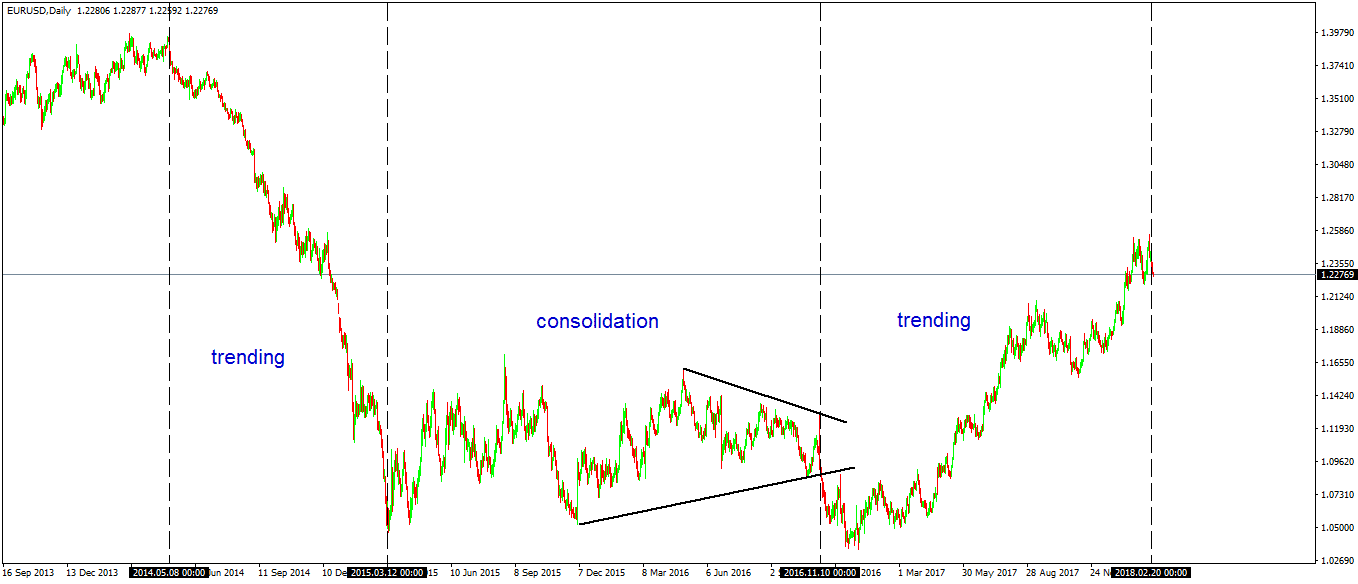
From 1.40 to almost parity it dropped like a rock. The FX strategy based on trend riding will strive here.
But then, it consolidated in a contracting triangle. For over two and a half years, it didn’t go anywhere.
Hence, trend trading strategies won’t help for all this time. But again, bills come in at the end of every month.
Suddenly, the market doesn’t move. And just like that, traders feel the need to do something.
Guess what? That’s the beginning of the end.
Doing something when the market consolidates means overtrading. Therefore, the smallest swing against the trading account and you’re out.
So, if you do trade for a living, you:
- Start with enough capital
- Have capital to last long consolidations
- Have a Forex trading strategy that works
Fundamental FX Trading Strategies
Now that you know the minimum conditions to stand the test of time, a proper FX strategy will help. Big time!
But how to find it? Here’s a hint: start with what kicks you.
Yes, what is that you love about the market. Do you like looking at charts? Are you fascinated by trend lines and indicators?
If yes, then technical analysis suits you best.
Or you love comparing economies? Moreover, you look at the two currencies in a currency pair as the result of two economies’ strengths and weaknesses?
If that’s the case, fundamental analysis works for you. Here’s what makes a fundamental FX strategy best:
- Time Horizon. Trading fundamentals means trading macroeconomic differences. Hence, it takes time for a trade to come to fruition. Moreover, picking tops and bottoms becomes tricky. Therefore, the biggest risk is traders enter a trade
- Capital Needed. As a rule of thumb, fundamental traders need more capital. That is, more than technical ones. It is one thing to spot economic troubles, for example, and another thing for them to reflect in a currency’s strength/weakness.
- Economic Calendar. Make sure you understand the economic calendar. First, make a rule to check it every day. Second, always look for the week ahead, as the market tends to position earlier most of the times. Finally, filter the noise. Or, stick with the events that matter.
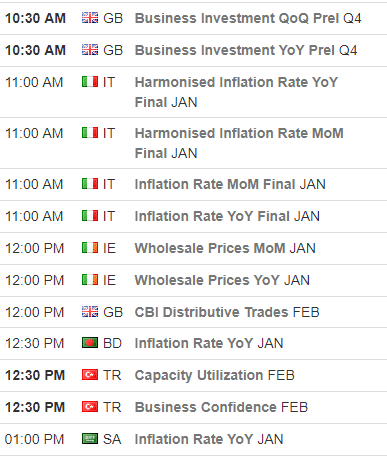
The table below shows a typical trading day. A simple Forex strategy from a fundamental point of view would be to ignore second tier data. It won’t move the market.
Instead, focus on the data that matters. Usually, this one appears in bold characters or with red color, just to highlight its importance.
Technical Trading Strategies
Technical trading means using technical analysis. Therefore, traders use technical tools to identify potential future market moves.
Most popular involve:
- Pattern recognition strategies
- Trend trading strategies
- FX strategy based on oscillators
- Forex trading strategy that works using trading theories
Technical traders are some sort of “wizards.” Yes, the term is correct.
They use historical prices to forecast the future. But how can anyone predict the future?
Because the Forex market is the sum of human behavior (decisions), predicting the future works. Or, it works most of the times.
Forex Trading Strategies for Beginners – A Pattern Recognition Approach
Old school technical analysis belongs to pattern recognition. More precisely, traders documented specific patterns.
Noticing the price action keeps repeating, they established rules. Next, those rules became known to the entire world. Finally, traders use them religiously on all markets.
The funny part is that most of the patterns belong to different markets, as:
- Commodities markets. Gold, silver, corn, rice, etc… people traded them before the Forex market became available.
- Stock market. Most patterns come from it, as it represents the mother of technical analysis.
Nowadays, traders build an FX strategy on patterns developed on other markets. Will they work?
To some extent, they do. Think of a head and shoulders pattern like the one below.
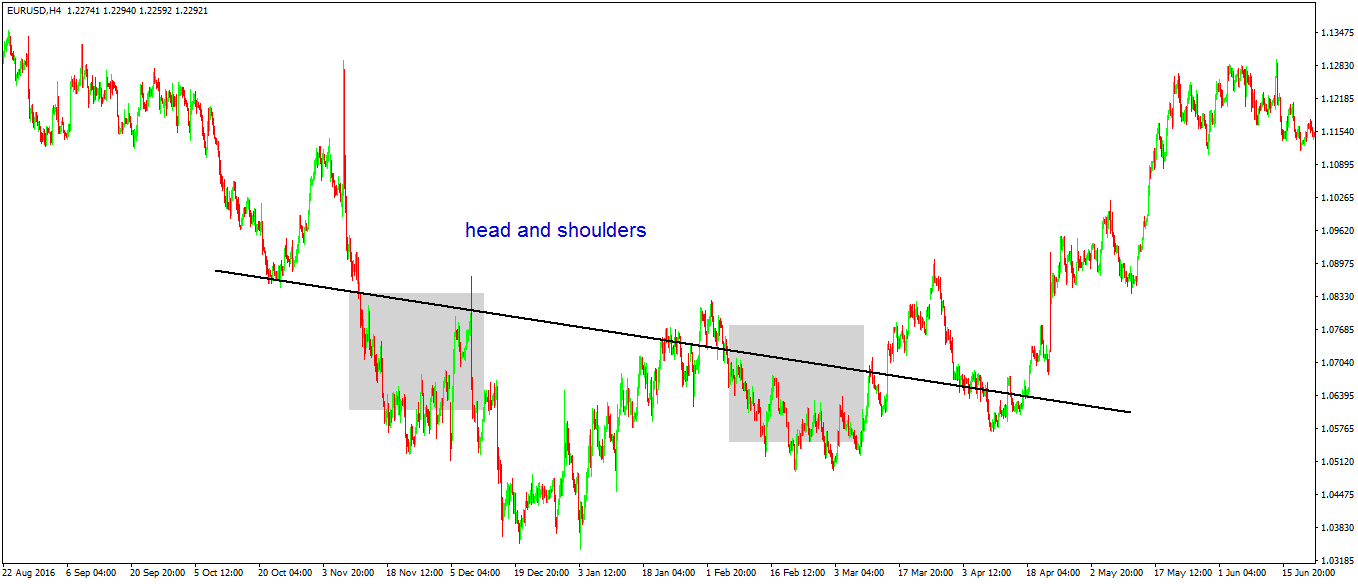
It reverses a trend. I mean, that’s the whole idea of it, as a reversal pattern.
However, different players trade different markets. First, these patterns fail often on the Forex market. Second, trading algorithms or automated trading spot them easily. Finally, they’ll trip the stops.
The following classic patterns stood the test of time:
- Head and shoulders
- Wedges
- Double and triple bottoms
- Pennants
- Bullish and bearish flags
- Ascending and descending triangles
Also, the Japanese approach uses patterns. Here’s a list of the most important ones:
- Hammer and shooting star
- Dark-cloud cover and piercing
- Morning and evening stars
- Bullish and bearish engulfing
Can one have a Forex trading strategy that works using these old-school patterns? The right answer is yes.
How come? Because they have clear rules!
As such, money management ratios and systems work correctly.
FX Strategy Using Trend Trading
For the technical trader, a trend is like day-dreaming. Everyone wants to ride it! Few make it!
Here’s why:
- Trends don’t form so easy
- Human nature (g., greed and fear) plays a trick on us
Therefore, traders face tough choices all the time. The main idea is to ride the trend as it lasts. ‘Till its end!
But, how do we know when it ends? Some trends last for a day or less.
Others, for a week or more. Finally, some last for years. Or even decades-long trends exist.
In trend trading strategies, the enemy is, again, the trader. Imagine Friday comes.
And, according to your strategy, the EURUSD pair trends higher. So, the entire week you rode the trend, enjoying nice profits.
However, over the weekend, there are some elections somewhere in Eurozone. Therefore, the real question to face on Friday is: should I book the profits? Or, keep the trade over the weekend?
You see, fear or greed rule traders. Most of the retail traders won’t resist temptation.
You always wonder and think of the ways you would spend the profits. And, in the end, you get out.
In a way, it’s normal. First, they usually have small trading accounts. As such, won’t resist a counter move easily.
Second, they keep stop losses too tight. While this is good as it cuts losses early, it is a lousy FX strategy when trend trending.
Finally, they lack patience. Patience is a virtue, and the trading arena is the perfect place to exercise it.
Best Forex Indicator – Oscillators
Still, on the technical side of trading, oscillators differ than trend indicators. They aim to provide more intelligence to price action.
Technicians all over the world tried various methods to past prices. Mostly based on mathematical ratios and strategies, oscillators make similar moves with the actual price.
However, there’s a difference. Before plotting a value, an oscillator considers multiple periods for it.
For example, imagine an oscillator on the weekly chart. And, based on the 14 periods. It means it considers the previous fourteen weeks before calculating the current value.
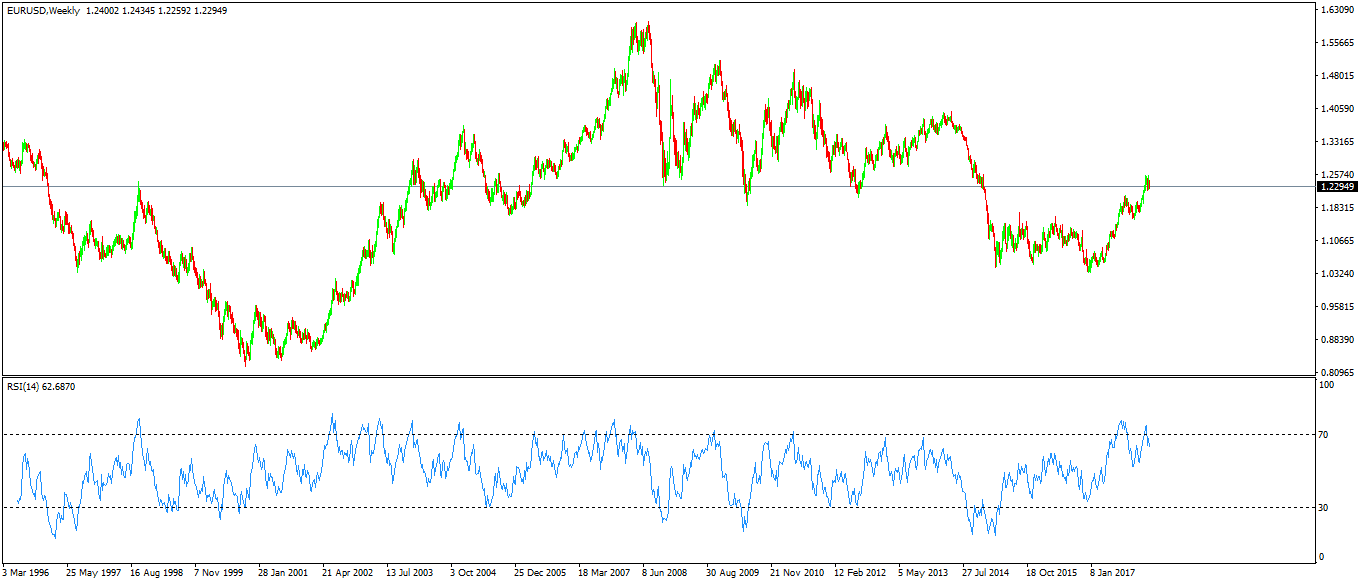
Above, the EURUSD weekly chart has the RSI (Relative Strength Index) at the bottom. It shows how the RSI reflects the price action.
Traders look for two things:
- Buy oversold and sell overbought
- Divergences
That’s what every oscillator shows. First, it has some levels that define overbought and oversold conditions. In the RSI’s case, these are 70 and 30.
Second, they look for divergences between the price and oscillator. And, stay with the oscillator.
Finally, the decision to buy or sell comes.
Yet, the most significant mistake is to use multiple oscillators on the same chart. If they all show the same thing, what’s the point? The chart will look overcrowded, just like below:
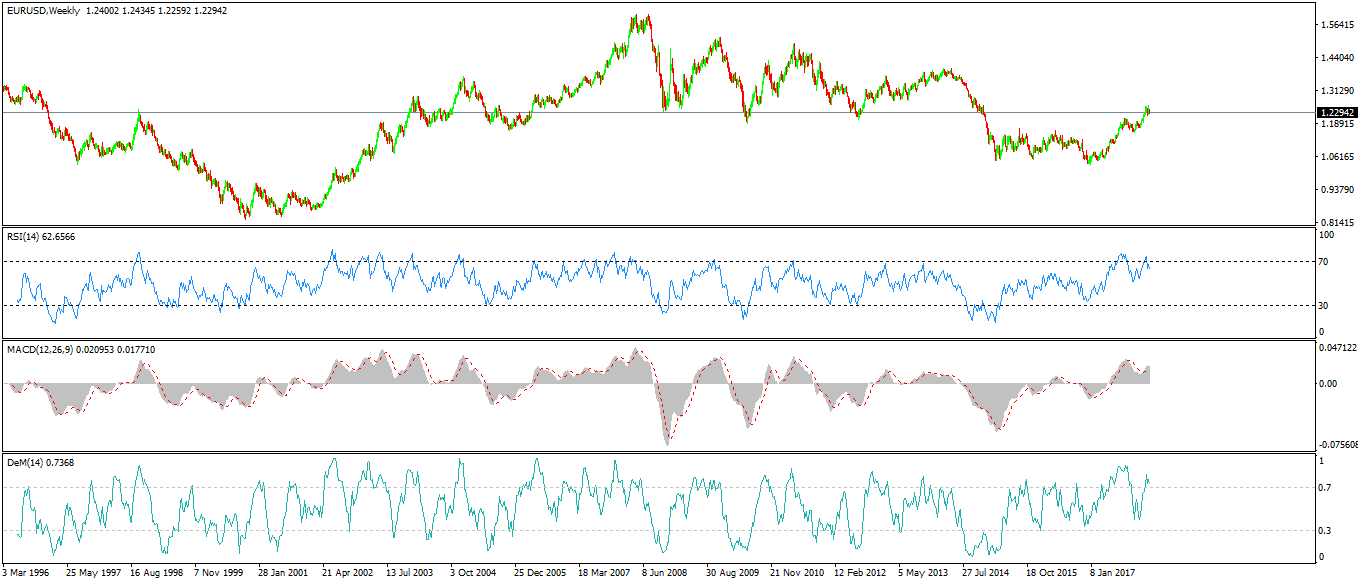
The same with trend indicators. If they all show the underlying trend, what’s the point of having more than one?
Hence, the right FX strategy should use, at best:
- One trend indicator
- One oscillator
Trading Strategies that Work – Trading Theories
A trading theory differs than patterns. While it has specific rules, it claims to apply to the entire market.
A pattern, on the other hand, reflects the price action during a specified time.
Therefore, trading theories have more complex rules. Discipline is key to an FX strategy that uses trading theories.
Take the Elliott Waves Theory for example. While simplistic as an idea, it becomes super-complex when going into more details.
However, if respecting all the rules stated, the Elliott ends up being one of the most powerful trading theories that exist. It claims to understand human nature’s interaction with any market…Hence, it should work!
In time, many tried to understand financial markets. When doing that, they researched, took notes, draw conclusions.
Just like that, a trading theory appeared. But most of them are old. Moreover, like with technical indicators, none considered the Forex market.
Hence, should we take trading theories with a grain of salt? If we do that, we should disregard the entire technical analysis concept.
Or, we know any trade represents the combination of technical and fundamental factors. Therefore, traders need both for the perfect FX strategy.
Old trading theories still exist to this day. They stood the test of time, like:
- Gartley theory
- Elliott Waves
- H. Gann approach
- Point and Figure
- Astro trading
But also new ones appeared:
- DeMark approach
- Drummond Geometry
- Market correlations
Because society changes, trading will change too. In time, new financial products will appear. Who heard of Forex a few decades ago?
As such, new trading theories will appear, to keep up with the changes.
Forex Scalping Strategies
There is one way to avoid everything mentioned above. What if there’s an FX strategy that avoids trending.
Or, it doesn’t matter if a currency pair trends or not. It’ll work.
Moreover, it avoids knowing everything about trading theories. Who cares? It’ll work.
The so-called scalping approach to technical analysis deals with time. More precisely, with the time horizon of a trade.
Inspired by algorithmic trading, (a.k.a. hedge fund industry), scalping represents the retail trader’s way of short-term trading. However, there’s a difference.
While professional algorithmic trading involves thousands of trades per second, the retail traders (humans) cannot do that. Instead, a scalper will enter and exit multiple trades per day.
Moreover, will not keep any position open at the end of the trading day.
As such:
- Negative swaps don’t become unnecessary costs
- There’s no need for the market to trend on bigger time frames
But:
- Scalpers pay more in commissions and fees
- Intraday news affects the entry and exit levels.
That’s the biggest problem with scalping: news. More exactly, economic news.
When economic news comes out, and the market goes against a position, the stop loss becomes a problem. The current technologies used by brokers have stunning performances.
But, when volatility rises, execution won’t work correctly. Because scalping needs excellent execution, most strategies in this area fail.
An FX strategy that uses scalping needs:
- State of the art execution
- Mind-blowing money management
- Small to tiny time frames
- Discipline, discipline, and some more discipline.
Conclusion
A viable FX strategy has no recipe that works under any conditions. Instead, it is a combination of multiple factors.
Traders should start a due-diligence process before deciding what to use in Forex trading. As part of it, they should think of what they bring to the trading table.
Dedication and patience, time (screen hours), discipline, are often the ones that make a difference. They represent the traits of a good money manager.
People think of a money manager as a person who deals with another people’s money. While this is true most of the time, in retail Forex trading things differ.
Every trader should be a money manager. After all, he/she manages the funds in the personal trading account.
There’s no harm in looking at what others do. Or did.
As such, learning from the best Forex trading strategies that stood the test of time would help. Or, check technical trading strategies to see if they fit your trading style. And so on.
In the end, it is a learning process. It starts with curiosity. And, it grows from passion.
Under no circumstances there’s one size fits all formula for the right FX strategy. Instead, it is about testing. And knowing yourself as a person.
This is how you’ll come up to know yourself as a trader too. An impatient person can’t ride a trade. It’s impossible.
He/she wants quick profits and has no time to wait for the trend to unfold. Scalping works instead.
It is just an example to show that human nature, the way we are as persons, affect our decisions in the market. And now you understand how complex it is to find the key to the perfect FX strategy on a market such complex as currency trading is.
